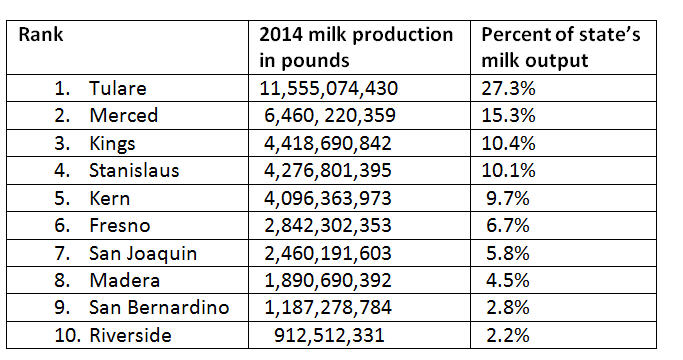Where California's Dairy Industry Dominates
Numbers show how milk and cheese production stand tall in – and out – of the Golden State.
California’s dairy industry isn’t only the largest milk producer in the nation. Even within the Golden State -- which produces more than 400 agricultural commodities and leads the U.S. in cash farm receipts – milk is the top agricultural income earner.
In 2013 (the latest numbers available), milk production generated $7.6 billion, according to the California Department of Agriculture (CDFA). Almonds were second with $5.8 billion, followed by grapes at $5.6 billion.
In 2014, California’s 1,485 dairies produced 42.337 billion pounds of milk – or about one in every five glasses of milk nationwide. That represented a 2.6% increase over 2013. California also leads the nation in the number of milk cows, with 1.78 million.
In its March 2015 California Dairy Review, CDFA ranks the state’s top 10 milk-producing counties for 2014:

While California recorded 32 counties that produced milk last year, the top 10 represented 94.8% of the state’s total milk output, CDFA reports. Tulare, Merced and Kings together accounted for 53% of California’s milk production.
Among the top 10 counties, Madera recorded the largest increase in milk production, rising 6.68% over 2013’s total. The Southern California counties of San Bernardino and Riverside recorded 2014’s largest milk-production decreases from the previous year, falling 5.7% and 1.67%, respectively.

In 2014, California ranked second in national cheese production. Wisconsin led with 2.48 billion pounds of cheese, according to the Wisconsin Milk Marketing Board. California’s 2.42 billion pounds in total cheese production was a record for the Golden State. Wisconsin accounts for about 25% of U.S. cheese production, while California produces a little over 20%.
Cheddar, Monterey and Mozzarella accounted for some 85% of California’s cheese production last year, with Mozzarella representing more than half of the cheese produced.
New numbers for 2014 are expected out in the next couple of weeks, CDFA says. But statistics for 2013 show that about 44% of California’s milk supply went into cheese. About 34% went into butter and dried milk powders.
Note: Chart and graph from California Department of Food and Agriculture







